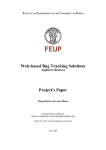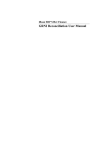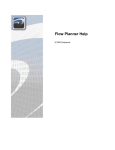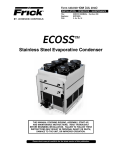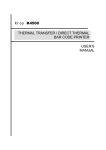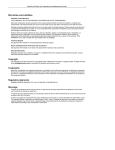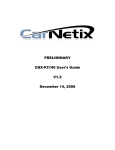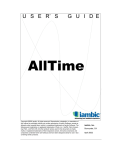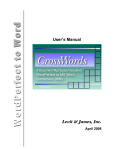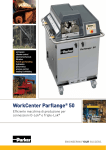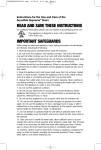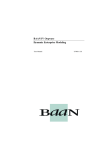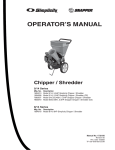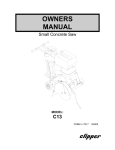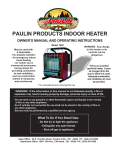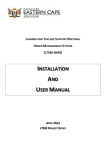Download MacPac Overview
Transcript
MacPac Overview MacPac is a fully integrated MRP 2 system covering Manufacturing Distribution and Financials. It is used in most countries world-wide. It is a modular system based on the proven IBM iSeries technology. It uses the OS/400 relational database and takes advantage of the IBM security processes including journaling and commitment control. There are approximately 30 modules as the following shows: MacPac for the IBM AS/400 i Series Customer Service Synchro Production Control EDI Process Control Order Processing Sales Analysis JIT/ REPETITIVE Expert Configurator CONBON Planning Forecasting Materials Management Master Scheduling Job Control Requirements Planning Inventory Control Capacity Planning Financials Accounts Receivable Costing Job Costing Product Costing Inventory Accounting General Ledger Accounts Payable RS Draft Mngment Purchasing Multi-Plant/ Transfer Control Common Item Features Definition Process Definition Bill of Documents Electronic Data Collection Electronic Installation & Data Maintenance Interchange Facility Multi-Facility/International Processing / CASE / Performance Management Some selected module information Design Engineering Description The Design Engineering (DE) application is the foundation of the entire MACPAC system. It is always the first application installed. DE stores and maintains information about all items that your business sells, produces, and buys. The following information related to items is maintained within Design Engineering. Part Master File Data. This data includes information, such as part number and description, that identifies the item. It also includes information about the item's properties that control how it is treated by other applications. For example, Design Engineering stores the lead time needed to manufacture or purchase each item. The Requirements Planning application uses this lead time to determine when production should be started or when a purchase requisition should be placed to meet projected needs for the item. Additional fields are available on the file so you can define your own part data. You can define the same part in more than one plant. Because each plant could use the same item differently, a separate Part Master record is created for each plant. A Plant field differentiates the records. The Plant field is displayed in the upper left corner of screens and printed on the upper right corner of reports. Although you need to create a separate Part Master record for each plant, the Copy Part Maintenance conversation makes it easy to copy records from one plant to another. Part Comments. Up to 99 lines of text can be stored within Design Engineering for each part. Note that documentation related to parts and manufacturing operations can be tracked using the Bill of Documents application. Part Costs. An unlimited number of cost elements may be defined for each part. The cost elements define the detailed breakdown of the total cost of procuring a part. These cost elements may be designated as material, labour, or overhead costs, and may be categorized as acquisition costs (costs paid to a vendor) or as add-on charges (freight, handling, material, overhead, etc.). The total costs and associated detail for manufactured parts are calculated automatically by the cost generation function in the Product Costing module. Product Structures. Design Engineering maintains bill of material specifications for all manufactured parts. On the Part Master File, you define the standard batch quantity used for producing each manufactured item. The batch quantity defaults to one, providing traditional, unit-for-unit control over discrete manufacturing processes. On the Product Structure File, you define the quantity of each component required to produce one batch of the item. You also define the scrap (as a quantity or a percentage) that is expected, and should be planned for, at each level in the product structure. You can also define a yield factor (on the Part Master File) that is used to calculate the expected yields of manufacturing orders (in discrete environments) and flow schedules (in flowbased environments). A mass change conversation allows you to replace one component with another on all relevant product structures and/or modify the amount of the component that is used to make its parents. Engineering Change and Revision-Level Information. This data helps you control how and when engineering changes are put into production. The Engineering Change Order File stores a description of each engineering change by change order number. The Revision Level File allows you to define and track the various versions of an item's design. For more information, see the Engineering Control/Revision Level Processing key concept. Although Design Engineering maintains a great deal of information about what items your business uses and what components are required to make each manufactured or build-thru part, it does not specify what manufacturing steps are used in producing those parts. Production steps are defined in the Manufacturing Engineering application. In addition to storing information related to individual items, Design Engineering also maintains information about how your business is organized. In general, this information must be defined before parts are defined because it is used during part definition. The following information is maintained. Plant and Warehouse Descriptions. Within MAC-PAC, a plant is defined as a single manufacturing facility, including all procurement and distribution activities related to the manufacturing process. Each plant may be made up of several warehouses--one manufacturing warehouse and multiple distribution warehouses. Manufacturing warehouses use standard costing; distribution warehouse use moving average costing or standard costing. Items, product structures, engineering change orders, and revision levels are defined separately for each plant. Each warehouse can have a separate work day calendar. Related Items. Related items can be defined for a given part. Two types of related items have been pre-defined complementary items and substitute items. When you order an item, the order processing user may be able to suggest other items that you may want to purchase which are complementary to the original item ordered. This would be a complementary relationship. When you order an item that is backordered and you cannot wait to receive it, the order processing user may be able to suggest a substitute item to be purchased instead. This would be a substitute relationship. Additional relationship types can be defined on Reference File category G91. The related items are displayed in a pop-up window when invoked from the Sales Order or Quote Order Maintenance conversation. This window will display the list of related items, the related item descriptions, as well as the available quantity for each item and the base price. Only those related items that exist on the Warehouse Balance File for the company/warehouse being processed are displayed. For more information, see the Key Concepts and Procedures section of this manual. Definitions of Inventory Locations. Inventory locations are areas within a warehouse, such as receiving, staging, production operations, and shipping, where inventory may be stored, and where inventory balances need to be maintained. Several MAC-PAC applications use these definitions to determine where an item is at a given time. On the Part Master File you can specify a primary location and a simultaneous-issue-and-receipt location for each part. Container Specifications. Containers are used in a flow environment to store material used at or produced by a manufacturing cell and may be owned by a plant, customer, or vendor. After all containers are defined on the Container Master File, the primary container used to store each part can be identified on the Part Master File. The CONBON application uses this information to calculate card quantities, and the Just-in-Time application uses this information to monitor the flow of materials during production. Note that containers are defined (and assigned to parts) only in a just-in-time flow environment. Container management can be used to record and track container inventory balances. System-wide Control Information. Because it is the first application installed and is required in all installations, Design Engineering is used to define some systemwide control parameters. This data is stored centrally on the System Control File. It includes the company name (printed on all reports), error messages, warehouse calendars, and options that determine what transactions will be printed on the system's transaction register. Manufacturing Engineering Description The Manufacturing Engineering (ME) module is typically installed in environments where shop floor movements are tracked through routings. A routing is a plan for how each part moves through a plant’s workcenters during the production process. A workcenter is an area where people and machines work together at a certain rate and cost. A workcenter can be a set of machines, one machine, or an assembly line. The Manufacturing Engineering module is required to install the Shop Floor and Capacity Planning modules in MAC-PAC, because routing and workcenter information is central to how these modules operate. The following information is maintained within Manufacturing Engineering. Workcenter Description File Data This data includes information, such as workcenter number, description, and department assignment (departments are defined in Design Engineering), that identifies the workcenter. In addition, descriptive information about the workcenter's properties controls how it is treated and used by the various applications within MAC-PAC. For example, the Workcenter File stores the machine/labour paced flag for each workcenter. This flag determines the scheduling logic used for all parts whose routings include the workcenter. MAC-PAC also uses the flag, together with information from the Workcenter Rates File, to determine total standard and burden costs for a part. One key piece of information maintained for each workcenter is the workcenter's capacity. Capacity information is used in the Capacity Planning module to determine what resources are needed to meet planned production. You can define the same workcenter in more than one plant. A separate workcenter record is created for each plant. This feature allows different plants to use the same workcenter for different applications, with different descriptive and rate information. The plant is displayed in the upper left-hand corner of screens and printed in the upper right corner of reports. Although you need to create a separate workcenter record for each plant, the Copy Workcenter Maintenance conversation makes it easy to copy records from one plant to another. Workcenter Rate Data The Workcenter Rates File contains each workcenter's rate codes, descriptions, and current and standard rates. This information allows you to assign multiple labour and overhead rates to the workcenter. You may define an unlimited number of rate codes; for each code you may indicate whether the rate is a labour or an overhead rate and whether the rate applies to machine or labour hours. Each rate code may be associated with a unique general ledger account number. For processes that occur outside your plant, outside processed workcenters are defined. The cost each part incurs as it passes through each outside process is stored on the Miscellaneous Cost file. Multiple cost elements can be defined for each part/miscellaneous workcenter combination. You also define whether the total miscellaneous cost is fixed or variable, and whether it should be regarded as a material, labour, or overhead cost. Routings Manufacturing Engineering maintains routing specifications for manufactured and transfer parts. On the Part Master File in Design Engineering, you define the standard batch quantity used for producing each manufactured item. The batch quantity defaults to one, providing traditional, unit-for-unit control over discrete manufacturing processes. On the Routing File, you define the rate per hour used to process the part at a particular operation/workcenter. For the fixed time operations that are batch sensitive, this processing rate is defined for one batch of the part. For fixed time operations that are not batch sensitive, and all variable operations, this rate is defined for one unit of the part. The Routing File also contains typical routing data such as the operation type (for example, standard or overlap), setup hours, and the number of persons and machines required. On the Routing File, you can specify if a particular operation within a part's routing is batch sensitive. If a workcenter is batch sensitive, producing a quantity that is a certain percentage greater than the normal batch size will require the same amount of time as producing two batches. For more information about batch sensitivity, see the Key Concepts section. The Manufacturing Engineering module also contains a program that generates the lead time for an item, based upon its routing. This program automatically updates the Part Master File with the calculated lead time. Manufacturing Engineering calculates the run units (or run days per piece) and uses this information together with the lead time to determine the start and due dates for manufacturing orders of certain order quantities. Orders for components are offset by these calculated lead times, so that the planned manufacturing orders, purchase requisitions, and transfer requisitions developed by the Master Scheduling and Requirements Planning modules are scheduled in the appropriate periods to meet the master production schedule. Note that Design Engineering contains a separate program that calculates cumulative lead times for manufactured items. The cumulative lead time includes the lead time to make the part and the lead time to make (or purchase) all of its components (down to the lowest level). All workcenter and routing information is used for scheduling operations in the Shop Floor Control module. The Product Costing module uses workcenter rates and routing information to determine the total labour and burden cost components of a product. Inventory Control Description The Inventory Control application is designed to provide materials management personnel with tools for planning, controlling, and analyzing inventory levels. Timely and accurate information is needed for effective planning and control. Online inquiry capabilities and immediate posting of inventory and orderrelated activity provide the framework for accurate and timely information. The installation of several key MAC-PAC applications can provide the Inventory Control application with additional capabilities. Before the Inventory Control application can be installed, the Design Engineering application must be operational. This application sets up a data base that defines the various parts used by the Inventory Control application. In a manufacturing environment, the Shop Floor Control application can generate the labour requirements for manufacturing orders and provide further control over manufacturing order quantities at the operation level of detail. Installation of this application, however, is not required for the installation of Inventory Control. The Requirements Planning application satisfies the material requirement needs for a manufacturer. Order action is suggested based on the current inventory position and the stated requirements for all parts. Order action suggested by Requirements Planning Generation is acted upon in the Inventory Control application. The Inventory Control application performs three major functions: material planning, material control, and inventory analysis. The maintenance, reporting, and inquiry capabilities provided by the application are organized according to these functions. Material Planning The material planning function encompasses several subfunctions. · Maintaining manufacturing orders for parts. Manufacturing order description, quantity,date, and user-defined information is maintained simultaneously with the component requirements for that order. If the Shop Floor Control module is installed, labour requirements information can also be maintained for manufacturing orders. · Order shortage and part availability reporting assists users in evaluating short- and long-term inventory and on-order positions. Short-term inventory needs are evaluated through an order release horizon, which serves as a cutoff period. Order shortage reporting is used to evaluate short-term inventory levels. It highlights components, for those orders scheduled to be started within the order release horizon, whose quantity requirements cannot be met with on-hand inventory. Part availability reporting is used to evaluate long-term inventory levels. It highlights parts whose quantity requirements and start dates for orders cannot be met with the available inventory and on-order amounts. · Online status of manufacturing orders and part availability is displayed through inquiry capabilities. · An inquiry feature is provided for display of orders that are scheduled for release within the order release horizon. One or more orders can be selected for release through this inquiry. Material Control The material control function involves the movement of inventory among stock locations/companies/warehouses. · Inventory movement is controlled between orders and inventory. This movement can be accomplished through the use of two transactions: Component Issues request material from inventory for use in the manufacturing process. For parts that do not require issue control, a simultaneous issue and receipt option (SIR) can be selected. This option allows automatic withdrawal from inventory of a specified quantity of a component upon receipt of the parent part. Manufacturing Order Receipts move completed production units from work-in-process to inventory. · Inventory movement is controlled among inventory locations. This movement can be accomplished through the use of two transactions: Inventory Adjustments increase or reduce inventory to account for adjustments. User-defined adjustment codes can be established to identify the type of inventory activity (increase or reduction). Stock Transfers record the movement of inventory among company/warehouses, among locations within a company/warehouse, or among inventory categories (balance types). Inquiries are provided to display the online status of inventory by part, location, and company/warehouse. Inventory Analysis The inventory analysis function involves the ABC classification of parts, and the verification, adjustment, and monitoring of inventory levels. · Parts are assigned an ABC classification. User-specified classification criteria guide the classification of parts into ABC classes. ABC Inventory Classification reports list parts within company/warehouse to allow review of usage and performance. · Cycle counting is performed to verify and monitor inventory accuracy. Cycle count schedules are produced based on user-specified criteria. Warehouse personnel count inventory of the selected parts. System and actual counts are reconciled online. The cycle count performance report is produced to allow review of inventory accuracy. Just in Time Description The Just-in-Time (JIT) module provides a comprehensive set of tools for planning and controlling production for repetitive or JIT processes. JIT uses online rate planning techniques to plan supply and demand in a uniform, flow-like fashion for parts defined as JIT-produced. The resulting plan is orderless and smooth, facilitating execution by a pull production system. With pull production, actual part consumption drives replenishment production with no direct tie to the material plan. The Just-in-Time module has two major functions: Just-in-Time Planning and Just-in-Time Control. Just-in-Time Planning involves definition of production rates and maintenance of production schedules. For JIT parts, MAC-PAC plans production by rates instead of by manufacturing orders. The JIT supply and demand planning process uses a rate record called a flow authorization (FA) to establish and store rate data. Flow authorizations state part production, and flow requirements (FR) state component demand. To help plan flow authorizations, the system maintains user-defined planning periods called flow intervals. The system initially plans flow authorizations and flow requirements by flow intervals, but the user may adjust the flow intervals to span any desired number of days greater than or equal to one week. Users can change supply rates by part within a particular cell in either daily or weekly quantities by using the Daily/Weekly Production Schedule Maintenance conversation. Each screen displays multiple parts that may be made at the cell and their supply rates. An over/under bucket is displayed on the Detail screen of this conversation to show either past-due production (indicated by an asterisk (*)) or over-production for each part since the cell's last synch date. The synch date indicates the date on which flow authorizations and flow requirements were last synchronized. The synchronization processing closes all FAs and FRs for a cell that begin before the current date, and splits and re-adds any FAs and FRs that end on or after the current date. This processing may be activated by pressing a command key and updating the schedule. Availability, load, and capacity rates are also displayed for each part in each bucket on the screen. Users may also change supply rates by cell for a particular part in the Part Production Schedule Maintenance conversation. This conversation makes it easy for users to schedule a part in multiple production centres at once. The Detail screen of this program also shows an over/under bucket for past-due or over production since that cell's last synch date. The synch date indicates the date on which flow authorizations and flow requirements were last synchronized. You may synchronize a part in this conversation. The synchronization processing closes all FAs and FRs for a cell that begin before the current date, and splits and re-adds any FAs and FRs that end on or after the current date. This processing may be activated by pressing a command key and updating the schedule. For each daily bucket, supply quantities, run units, and availability rates are also displayed. Total load for the part on the production centre may also be viewed by pressing a command key. Both of these conversations serve as tools to modify production rates to keep within a cell's capacity. They also act as a simulation or a worksheet to provide "what if" analysis for a cell or a part within multiple cells. These conversations are necessary to schedule a part in a production centre other than the main production centre defined on the Part Master File. Master Scheduling and Requirements Planning will only schedule a part in its main production centre. Therefore, if the user wishes to schedule a part in an alternative cell, production must manually be decreased in the main cell and added to the alternative cell. These conversations aid in determining supply rate changes and their effect on total load and availability without affecting the data base. When a final schedule is determined, the data base is updated. Once schedules are modified for a part, the system automatically generates component requirements (flow requirements). When these requirements are modified, their impact on the load at a particular cell is automatically updated. Just-in-Time Control involves reporting production to the MAC-PAC system. JIT production receipts and time recording transactions are reported by part rather than by order. Only a minimal amount of information is needed. However, these transactions provide all the information needed to calculate variances in Inventory Accounting. Requirements Planning (MRP) Description The Requirements Planning module satisfies the material requirements needs of a manufacturer. This module uses data maintained by other system modules to determine when materials need to be ordered. Order action is suggested based on the current inventory position and the stated requirements for all parts. The gross requirements for lower-level parts in the bill of material, the lot sizing rules, and lead-time information for each part are maintained in the Design Engineering module. The on-hand and on-order inventory levels for each part are maintained in the Inventory Control and Purchasing modules. Sales orders entered in Order Processing place demand on manufacturing sources when orders cannot be filled. Synchro also creates demand through customer delivery requests. Any order action suggested by the Requirements Planning Generation must be acted upon in Inventory Control. The Design Engineering and Inventory Control modules must be installed before the Requirements Planning module is installed. The Master Scheduling module generates requirements for the lower-level parts that are analyzed by the Requirements Planning Generation. The purpose of the Requirements Planning module is to provide an optimal inventory replenishment plan to support the master schedule of the manufacturing company. This plan suggests: what end parts are to be manufactured; how many of those parts are to be made; and when they are to be made. Clearly, the computerized generation of a replenishment plan cannot possibly analyze all factors associated with the production environment. The generated plan is not intended to assume responsibility for the ordinary function of the planner; rather, this plan is intended to support the planner's function. Requirements Planning also provides the information that production and material control need to meet their objectives: improved customer service, increased manufacturing productivity, and minimal inventory investment. This is provided through the three main functions of Requirements Planning: Requirements Planning Simulation/Generation, order action reporting, and additional reports that evaluate the reasonableness of the suggested replenishment plan. The major steps involved in the Master Scheduling/Requirements Planning Simulation/Generation process are illustrated in the following figure. Depending on whether the part is standard master scheduled or daily master scheduled dictates which route will be taken. For either part, a projection of market demand must first be entered. If the forecast is for a standard master scheduled part Master Scheduling will then suggest a tentative schedule based on projected demand, current stock levels, and target inventory levels. It compares this tentative schedule to capacity across key resources, and allows the planner to modify the tentative schedule as needed. Once a satisfactory schedule has been generated, Master Scheduling will create actual manufacturing orders, flow schedules, purchase requisitions, or transfer requisitions and suggest actions to be taken against existing orders, schedules, or requisitions. See the Master Scheduling User Manual for more information about tentative schedules for standard master scheduled parts. If the forecast is for a daily master scheduled part, the Requirements Planning module will then generate a simulated or actual schedule based on projected demand, current stock levels, and target inventory levels. A simulated schedule can be compared with capacity across key resources, and simulation maintenance allows the planner to modify the simulated schedule as needed. Once a satisfactory simulated schedule has been generated, simulation reconciliation will create actual manufacturing orders, flow schedules, purchase requisitions, or transfer requisitions and suggest actions to be taken against existing orders, flow schedules, or requisitions. Because copies are made of firmed, open and released orders, flows, and requisitions during Requirements Planning Simulation, Simulation Maintenance and Simulation Reconciliation can be used to implement the suggested actions to the "copied" simulated supply records on the actual supply records. The Master Scheduling & Requirement Planning Simulation/Generation Process Requirements Planning Simulation/Generation Requirements Planning Generation is the process of analyzing requirements for a part to determine whether inventory will be available when needed. Parts are analyzed in a top-down (bill of material) sequence. This ensures that the planning process will consider all requirements that are generated for lowerlevel parts. Requirements Planning Simulation uses the same process to generate a simulated schedule, allowing planners to analyze various planning process scenarios. Two aspects of the Requirements Planning Generation are especially important: · Reschedule Assumption: It is assumed that existing supply orders will be expedited to meet unsatisfied requirements before a planned order is added. When a shortage condition exists, it is realistic to assume that orders in process on the shop floor can be expedited and completed sooner than new orders. · Planning Process: The process is outlined as follows: 1. The beginning inventory position of a part is determined, as well as the safety stock for the part. 2. The existing dependent and independent demands for a given part are determined. 3. Requirements and/or supply orders for a given part are processed in time-phased sequence. This provides the opportunity to determine the exact date (if any) on which supply and demand for a specified part do not correlate. Appropriate action is suggested. 4. Replenishment orders are adjusted by the anticipated yield factor for the part. 5. Order action messages to expedite, add, cancel, defer, or decrease open or firm orders for a given part are suggested to the planner. No action is taken without action from the planner. 6. Planned orders for a given part are then manipulated as necessary to meet requirements. 7. If the Job Control module is installed and a job-controlled part is being planned, the following processing occurs: a. On-hand inventory for the part is accumulated over all locations for each job or job group. b. The part is then planned by job. (1) Each job's demand is netted against inventory and open orders for that specific job. (2) If the job resides in a job group and the part is purchased or a raw material, the inventory stored under that job group, or any purchase orders that exist for that job group, are also used when netting. (3) If an order must be planned for the part to replenish demand for a specific job, the order is created with the job number on it. Note: The planning policy for job-controlled parts is always as-required. Occasionally, there may be situations, such as during backflushing, which result in negative inventory. Although you may want to ignore this negative inventory, during RP generation, orders and requisitions will be created unnecessarily. Therefore, two options are available that will allow you to ignore negative inventory, one at the part level and one at the plant level. The option to ignore inventory at the part level is defined on the Part Master Productivity screen. A value of 'I' in the Inventory Netting flag indicates that negative inventory balances for the part will be ignored during RP Generation. This value will be allowed for all part types that are planned by RP. Standard master scheduled parts and job-controlled parts will not have the option to ignore negative inventory. The second option, at the plant level, will be defined on Reference File category N35, RP Defaults by Company/Warehouse. On this category, you can specify whether negative inventory balances should be ignored for all RP parts in a plant (manufacturing co/whse), or whether only specific parts will have negative inventory balances ignored. If 'I' is entered in the Netting Override flag field, then negative inventory will be ignored at the plant level for all RP parts in the plant. If 'P' is entered in this field, then the Inventory Netting flag on the Part Master File will be checked for each part in the plant. During RP generation, whether it's selective, net, or full, category N35 will be checked for each plant processed. If 'I' is found, then negative inventory balances will be ignored for all parts in the plant. If 'P' or no record is found, then RP will ignore only those parts whose Inventory Netting flag is set to 'I' on the Part Master file. When negative inventory is ignored for a part during an RP generation, a warning message will be written to the RP Order Action, Planning Action Review Detail, and Planning Action Review Summary reports. Likewise, a warning message will be displayed on the Requirements Review Inquiry detail screen to alert you that negative inventory balances were ignored. At the time of RP Generation, even though the negative planning balance currently is displayed in the Online Review Inquiry, Time-Phased Part Availability (another online inquiry) also shows the negative planning balance. The actual generation and simulation processing is discussed in the program description for the Requirements Planning Generation Program (RP100E), which is found in the Requirements Planning Program Documentation Manual. Order Action Report/Inquiry The Planning Action Report is a product of the Requirements Planning Generation. This report indicates which orders have exception conditions, and recommends the order action that would achieve optimal replenishment. The planner can use this report to recognize problem areas before they become critical. The planner can then evaluate which order action is reasonable and take the desired action. If the suggested order action is not reasonable, alternative solutions can be evaluated. Planned order maintenance is also included in this report to allow the planner to keep track of planned order activity. The Planning Action Overview Report contains data from the Planning Action Report that has been reorganized based on your selections. For example, you may request the report to contain data for a specific plant, vendor, part number, or other entity. You may also request that the report be organized in vendor, planner, or part sequence and in daily, weekly, or user-defined period buckets. You may access this same planning action data through the Planning Action Review Inquiry. This inquiry contains the same data as the Planning Action Report. It allows you to access all action messages online and call the maintenance, inquiry, and release programs needed to act on them. Data in this inquiry can be sequenced by vendor, planner, part, or low level code and can be limited by a number of specified entities such as plant, planner, low level code, vendor, ABC class, or job. Additional Reports Requirements Planning provides additional reports to enable the planner to analyze the reasonableness of the suggested order replenishment plan. The Projected Inventory Cost Summary enables the planner to evaluate the cost of implementing the replenishment plan, and to determine whether cost-effective alternative solutions can be initiated. Finally, an online inquiry allows the planner to review the current status of the order replenishment versus demand, on a part-by-part basis. The Part Depletion Analysis Report lists the projected date of inventory depletion for parts that have been designated as going obsolete. This report will allow you to record potential component substitutions that are to occur when current inventory levels have been deleted, to predict the date of inventory depletion, and to monitor changes in supply and demand against the predicted date and establish new depletion dates as needed. This should help you minimize obsolete inventory, and smooth the introduction of new components. See the Part Depletion Analysis key concept in this manual for more information. Purchasing Description The Purchasing application is designed to effectively manage all purchasing functions, from the initial identification of goods requirements to the final disposition of the received goods. The Purchasing application performs two major functions: Purchasing Planning and Purchasing Control. The maintenance, reporting and inquiry capabilities provided by the application are organized by these two functions. The figure below shows the relationship between these two functions and the underlying steps performed during each. Data Setup ® Requisition Entry ® Purchase Order Entry Receiving ® Statistical Analysis Purchasing Planning Purchasing Control Purchasing Planning and Control ® Purchasing Planning The Purchasing Planning function encompasses several subfunctions: · Initial data, such as source identification and pricing data, is set up and maintained online. Item sources are identified by creating item/vendor relationships. Purchasing data used for purchase order line creation is recorded with the individual item/vendor relationship so that it may be automatically retrieved during purchase order creation. Price data is recorded through quotations related to an item/vendor relationship. Several pricing strategies are supported. User-defined comments are maintained at the relationship and quotation levels. · Requisitions are maintained for a part. Requisitions may be created and maintained manually, or generated automatically by the Requirements Planning or Master Scheduling applications and manually modified or released. Requisition covering is made more efficient by specifying a buyer code and a priority code, so that the correct buyer can cover the most crucial requisitions first. The requisition amount can be controlled against a predefined maximum amount. User-defined comments are maintained. · Vendor Allocation enables the automatic assignment of purchase order requests to vendors. Item requisitions generated through Master Scheduling and Requirements Planning are automatically allocated to vendor. Vendors' quotas can be calculated using the annual Planned Quantity or the annual Planned Quantity Not Accounted For. Purchase Order releases are automatically allocated to the corresponding purchase orders. This can be done By Item or By Requisition. · Purchase orders are maintained online. Vendor information, purchase order line items, purchase order releases and user-defined comments at header and line levels are maintained simultaneously. Blanket orders allow periodic and regular purchases according to specific vendor agreements. Manufacturing orders requiring outside vendor processing (subcontracting operations) are controlled using phantom orders. Purchase order creation is facilitated by means of quotation, requisition, and manufacturing order searches, allowing the buyer to look up and retrieve the needed information online without exiting the purchase order creation conversation. Total purchase order amounts are controlled against predefined maximum amounts specified for an item/vendor relationship, a vendor, or a buyer. · Requisitions, item/vendor relationships, quotations, and purchase order lists may be displayed via online inquiry, with multiple selection criteria available to tailor the inquiry. · Reporting features enable analysts and buyers to perform their different tasks using only the reports and data they need. Purchasing Control The Purchasing Control function encompasses several subfunctions: · The workload of the receiving and inspection departments can be planned using the expected receipts reporting feature. · Purchase order receipts are maintained: The receipt process may be tailored according to the company's policies and special requirements for selected parts. Receipts are validated against the original purchase order. Simultaneous receipt and quantity control entries are authorized. Attention is directed to production part shortages. Quality control and related dispute processing is tracked and managed. Purchase order releases may be covered automatically based on counted quantity. - Material rejections are analyzed using system-defined quantities. General receipt information, receipt header, receipt lines, receipt parcel lines and user-defined comments are all maintained simultaneously. · Receipt status can be displayed by purchase order, part or vendor following multiple selection criteria. · Various documents and reports can be printed to enable the receiving staff to better follow the receiving process. · Statistical reports and inquiries provide a means of evaluating vendor and buyer performance. Interfaces The installation of several MAC-PAC applications is required before the Purchasing application may be used. Vendor data and Reference File categories are maintained by the Common Features application. The Design Engineering application is required to define and maintain the parts used by the Purchasing application. Stock balances and inventory information are maintained by the Inventory Control application. In addition, the Purchasing application provides interfaces to several other modules. Planned requisitions generated by the Requirements Planning and Master Scheduling applications may be maintained and used to create purchase orders. These two applications also will take into account any purchase order releases when generating requirements. Vendor data and billing information are passed to the Accounts Payable application. Purchase order receipt data is used by the Inventory Accounting application to determine variances. Expert Configurator Description The Expert Configurator is an embedded, knowledge-based system within the Order Processing module of MAC-PAC. It is used to simplify processing in custom sales order entry, pricing, and manufacturing environments. The functionality available within the Expert Configurator is also available on a PC through the Configuration Maintenance module. The Expert Configurator's primary functions are to: · Allow users to define and validate unique option select screens, and to select options from those screens at order entry. Users control what screens are displayed, what default values are used, and which option combinations are valid. · Determine pricing, at order entry time, based on selected features and options. · Generate manufacturing orders or requisitions corresponding to the selected features. The system allows you to use either traditional bills of material and routings or user-specified rules to generate component requirements and labour requirements for manufacturing orders. The Expert Configurator module supports multi-level and multi-plant configurations. Thus, multiple levels within a product structure may be configured, with each of the custom work orders or requisitions originating in any plant defined on the system. These functions are performed through the use of user-defined rules, tables, matrices, and variables. Each configured product can be associated with: · Three sets of rules: one for sales order entry, one for pricing, and one for manufacturing. Sets are also referred to as database types. However, all rules reside in the same database. · A set of permanent tables and matrices where the rules can access a variety of information. Sales order entry rules (distribution rules) define the features and options allowed for configured parts, as well as the validation criteria applicable to each possible feature and option. The options are displayed in a series of screens formatted dynamically by the configurator through the use of user-defined screen generation rules. The validation rules are executed for each screen entry. The manufacturing cost is computed later, during the manufacturing configuration process, but an estimated cost can be generated by executing a finalize cost rule during sales order entry. Pricing rules define the calculation logic applicable to compute the sales price of a configured part. Each configured part's sales price is computed individually, online at order entry time. An executed finalized price rule will override other pricing methods, including contract pricing. Manufacturing rules define the component requirements and the labour requirements for the manufactured configured part. The requirements for purchased or manufactured configured parts and the cost of the products are generated off-line in batch or asynchronously upon completion of the originating sales order. Matrices allow you to specify up to five dimensions of valid data combinations to retrieve a specific value. In a matrix, you can define unlimited numbers of values for given options, variations, or variables. Configuration codes allow you to more easily identify the options specified for a specific configured item. You may cost configured items according to the configuration code (Configuration Costing) and you may inquire upon inventory based on the configuration code. You may define a Configuration Code Template to break the configuration code into meaningful elements. Using a template ensures that the configuration code will be formatted consistently. Order Processing Description The Order Processing application performs four major functions: sales order maintenance, quote order maintenance, quote order conversion, and shipping and billing. The maintenance, reporting, and inquiry capabilities provided by the application support these four functions. Order Processing also provides the capability for electronically receiving sales orders and sending invoices and acknowledgments through the Electronic Data Interchange (EDI) module. In addition, the windows-based Sales Force Automation module runs on a remote PC and allows sales staff to enter orders at remote locations without having to dial into MAC-PAC. The normal order processing functions described below are not functionally modified during EDI or Sales Force Automation processing. For more specific information on these interfaces, see to the Interface with Other Modules key concept in this manual or refer to Electronic Data Interchange User Manual and/or the Sales Force Automation Online Help System. Sales Order Maintenance The sales order maintenance function encompasses several sub-functions: · Maintaining customer sales orders. Customer information, sales order line items and sales order comments are maintained simultaneously. Blanket order and backorder releases are created based on data on the original (parent) order. · Controlling customer sales and initiating the shipping process. Sales orders identify what the customer has ordered and the total amount of the order. Pickers identify the quantities to be picked and shipped. · Defining shipping parameters Sourcing warehouse, promised ship date, carrier, route, ship via, and the ship via's volume and weight capacities determine how sales order lines are grouped into order shipments. Load numbers can be entered to assign sales order lines to deliveries. · Controlling open orders and enforcing management policies. The sales order register identifies all orders entered since the last time the report was produced. Exception reports provide hard copy evidence of the credit, pricing, and availability exceptions that were detected in online processing. Audit trail reports identify changes to key order, line, and comment data. · Displaying (via online inquiry) the status of sales orders by order number, order line number, or shipment number. · Displaying (via online inquiry) documents, return authorizations, and invoices for a particular part number on a sales order or for an entire sales order. The transactions will be listed in date sequence. · Displaying the financial detail pertaining to all of the sales order lines for a specific customer. Quote Order Maintenance The quote order maintenance function involves: · Maintaining customer quote orders. Customer information, quote order line items, and quote order comments are maintained simultaneously. An expiration date is assigned to each quote order. · Controlling open orders and enforcing management policies. The quote order acknowledgment identifies all orders entered since the last time the report was produced. · Displaying (via online inquiry) the status of quote orders by customer, part, and order number. This function will be performed by the Sales Order Maintenance program. Two menu options will be available -- one for sales order maintenance and one for quote order maintenance. The processing for the two maintenance modes will be very similar, except that some functions will not be performed (such as inventory reservation) and some fields will not be displayed for quotes. Separate sets of files for quotes and sales orders will be used. Quote Order Conversion The quote order conversion function involves: · Converting quote orders into sales orders Sales order numbers can either be system-assigned or manually assigned to realized quote orders. Customer and order information from the quote order does not need to be re-entered or manually assigned to realized quote orders. This function will be performed from the Sales Order Maintenance Function Select screen by pressing F7-Quote Conversion. This method of converting quotes will provide greater flexibility by allowing you to copy from the quote selectively, as well as the ability to copy from the quote and modify it before ending the order. For more information, refer to the Order Entry key concept in this manual. Shipping and Billing The shipping and billing function involves: · Recording quantities shipped. Actual shipped quantities and stock location information are annotated on the picker for later entry. · Shipping the goods to the customer. Shipping information on the picker assists warehouse personnel in sending the goods to the customer. A Bill of Lading may also be printed for each shipment release of an order. · Printing packing and shipping paperwork. Paperwork such as Bill of Ladings, packing lists, and packing and shipping labels enable contents of shipments to be identified and verified. · Assigning serial numbers to the parts being shipped. These serial numbers allow you to track the inventory's flow as it is shipped and returned. · Entering quantities shipped and updating inventory balances. Shipped quantities can be entered against a previously entered sales order, or without previous creation of a sales order. Shipped quantities can be recorded against a previously entered and released sales order with minimal data entry requirements. Inventory on-hand and on order balances are automatically updated. Shipped or returned quantities and billing adjustments can be entered directly without previous order entry. Inventory on-hand balances are updated, if appropriate. · Updating accounts receivable data. Accounts receivable data for the customer is automatically updated. Accounts receivable and open order balances are updated based on total amount shipped, returned, or adjusted and include tax, special charges, and freight amounts. Accounts receivable open items are created to provide detail to support the total accounts receivable balance. · Creating billing documents. Invoice, debit memo, credit memo, or cash sale documents are created. These documents notify the customer of amounts due or credits received. The document types for these documents are defined on Reference File category 329. You may also generate instalment payments for an invoice based on the payment terms code associated with the order. · Creating a draft. A bill of exchange is created for an invoice in Shipping/Billing and in Postbilling/Memo Entry if the following conditions are present: - Consolidated invoicing is not used Customer is not defined with payment on a statement basis open amount is greater than zero and payment type is a bill of exchange If a draft is created for the invoice, then the next available draft number on Reference File category F37 will be retrieved and assigned to the draft. · Reporting activity. Register and audit trail reports identify the billing activity, quote order maintenance, sales order maintenance, and inventory movement that has occurred since the last time the reports were produced. · Accounting for shipping and billing activity. Transactions are created that account for shipping and billing activity. Shipment and return audit trail transactions are created for all inventory movement. These transactions are used to create journal entries that are passed to the General Ledger application. Accounts receivable, sales, and tax journal entries are created for all billing activity and are passed to the General Ledger application. Sales history transactions are created for each order line shipped. Shipment and return audit trail transactions also provide lot traceability in a lot-controlled environment. Inventory Accounting Description The Inventory Accounting module generates financial information based on inventory and manufacturing activity. Throughout each accounting period, activity is recorded in the Purchasing, Order Processing, Inventory Control, Transfer Control, Shop Floor Control, and Just-in-Time modules. When the period is closed, Inventory Accounting reads the audit trail files from each of these modules to determine what transactions occurred. Although you have the option of selecting which audit trail files are actually written (in Reference File category N23), MAC-PAC will not allow this option for any audit trails which feed into Inventory Accounting. Therefore, as you may determine whether or not most audit trails are written, Inventory Accounting audit trails and those which feed into Inventory Accounting are the exception to the optional audit trail feature. It applies standard costs to the transactions to determine the value of on-hand and work-in-process inventory and automatically creates journal entries to the general ledger to reflect these calculations. It also produces reports to help you reconcile and analyze fiscal period activity. The module fully accounts for the net change between beginning and ending stores, finished goods, and work-in-process inventory balances. Management Reporting If you are using the MAC-PAC General Ledger module, you may set up your financial system to distinguish between fiscal and managerial accounting transactions by defining two different types of accounts (fiscal and managerial). Fiscal accounting transactions are those subject to legal requirements while managerial accounting transactions are subject to internally defined requirements. If you set up your financial system for managerial reporting, you must define a reporting class (fiscal, managerial, or common) for the Inventory Accounting subsystem. The reporting class determines which types of accounting transactions can be made in the subsystem, and is assigned on Reference File category 026, Subsystem Reporting Class. For a fiscal subsystem, only fiscal accounting transactions are allowed. For a managerial subsystem, only managerial accounting transactions are allowed. For a common subsystem, all types of accounting transactions are allowed. Usually, when the management reporting option is chosen, the Inventory Accounting sub-system is set up with either a managerial (M) or a common reporting class (C). Inventory Valuation The value of inventory is affected by purchase receipts and returns, issues to production, receipts from production, customer shipments and returns, inventory transfers, and inventory adjustments. Beginning and ending inventory balances, as well as period activity, are calculated and reported. This information allows you to reconcile financial results and to monitor and analyze inventory levels. Inventory is valued using accounting, or frozen, standards. The total standard cost for a part includes material, labour, and overhead costs, made up of userdefined cost elements. For non-standard parts or warehouses defined as moving average, the system can perform moving average costing. You specify an initial cost for the part, and from then on an average cost is calculated automatically as transactions are recorded. The average cost is maintained under these conditions: · When inventory is received against a purchase order, based on the purchase price. · When inventory is transferred from another warehouse, based on the transfer price of the inventory in the transferring warehouse. · When inventory is shipped to a customer, based on the cost of the sale. · When inventory is adjusted and you have specified a cost or value for the adjusted inventory. WIP Valuation and Variance Reporting Inventory Accounting supports order-based production and flow production. For MRPII parts, the manufacturing order is used as the basis for reporting activity and calculating variances. For Just-in-Time (JIT) parts, the manufactured part is used as the basis for reporting activity and calculating variances. Material issues, labour hours, machine run time, miscellaneous costs, and finished product receipts affect the value of production, or work-in-process, inventory. In valuing inventory, Inventory Accounting applies standard costs to actual activity. It also compares the actual activity reported to standards you have established to help you determine whether your manufacturing process is performing as expected. Two types of variances are reported: · Order Closure Variances. Closure variances are calculated after a manufacturing order is complete and a grace period is elapsed. For JIT parts, variances are calculated by comparing all activity reported during a fiscal period for a part to its standard definition. · As-Incurred Variances. You can choose to report some variances as they occur, before the manufacturing order is closed. As-incurred variances are calculated for each routing operation that was completed during the accounting period. Using as-incurred variances allows you to remove variance costs from the work-in-process account before the order is closed. Journal Entry Generation Each business transaction affects at least two general ledger accounts. You define the specific accounts to be debited and credited for each type of transaction using account assignment tables, described in the Setting Up Account Number Categories topic. The journal entry records are passed and posted to the General Ledger module automatically. Account distribution and transaction detail reports provide an audit trail for all activity posted in a fiscal period. General Ledger Description Input to the system includes manual (and reversing) journals, entries from other accounting systems, intercompany journals, and recurring and standing journals. Journals are either prepared manually from source documents (such as vendor invoices, cash receipts journals, sales invoices, and material issue tickets) or generated by other computer systems (such as accounts payable, accounts receivable, order processing, and payroll systems). Account balances, statistical data, budget data, historical data, and processing control information are maintained on the Account/Centre Master, Budget Master, Cumulative Transaction, and Reference files. This information is combined with input report specifications to produce balance sheets and income statements, responsibility reports, user-defined analysis reports, budget reports, and transaction reports. In addition, the system supports the processing needs of users requiring value added tax (VAT) processing. Multiple VAT amounts may be recorded against a single journal transaction. The system generates accounting transactions for posting to user-specified VAT accounts and maintains a history of all VAT transactions generated. Financial Reporting Balance sheets and income statements present an organization's financial position. These reports can be produced at any time during an accounting period to report account activity at the time the reports are requested. Typically, they are prepared at period-end. Balance sheets and income statements can be prepared for each entity represented in the system and for all entities combined. Users control the sequence of accounts and define the report headings, line descriptions, subtotals, and totals printed on the reports. Users also specify the general ledger accounts that are combined into each account classification. Column headings are fixed but can be changed through minor custom modifications. Because the reporting requirements of each organization are different, the General Ledger module provides a multi-level reporting facility. This facility enables users to specify the organizational level or levels at which they want to prepare financial reports. The hierarchical reporting structure is illustrated in the figure below. The basic level of reporting is the location. Each location represents a business entity with a complete chart of accounts. The General Ledger module increases reporting flexibility by providing four additional reporting levels: centre, company, group, and combined entity. The following types of reports can be prepared: · Income statements for centres · Income statements and balance sheets for individual companies and locations · Income statements and balance sheets for groups (two or more companies or locations) · Combined or consolidated reports that analyze the accounts for all locations for all companies Account Analysis Reporting General Ledger users can prepare analysis reports that meet one-time or continuing reporting requirements without writing additional programs. Users define the format and content of each analysis report. Report formats are specified in a line/column (cell) matrix format. Users specify the financial, statistical, or budget amounts in each cell and the mathematical operations performed on the amounts. For example, a cell defined as "labour costs per unit" accumulates a financial amount and a statistical amount. To calculate labour costs per unit, the financial amount is divided by the statistical amount. After all cells are defined, the user specifies the descriptive captions associated with each column of data and each report line. Report formats can be used in multiple reports and duplicated through mass maintenance processing. In addition, mass maintenance can be used to create new lines or columns based on cells that have already been set up. To define the contents of each report, the user specifies the general ledger accounts, the amounts of which are extracted for accumulation in each cell. Individual accounts or account ranges can be specified. Mass maintenance processing can be used to duplicate extract specifications. This procedure allows like reports for a number of reporting entities to be created. Among the analysis reports that can be produced are: · · · · · · · Change in financial position reports Working capital summaries Gross profit summaries Revenue and expense account summaries Income statements and balance sheets for selected entities Analyses by account or account types Subsidiary ledgers Responsibility Reporting Responsibility reports measure an organization's periodic activity against current period, quarter-to-date, and year-to-date plans. These reports are used to monitor departmental performance and to analyze the activity of the organization's various centres. Users tailor the reports to match their management style and organizational structure. Information from accounts in any location can be combined on responsibility reports. Users define the report headings, line descriptions, and levels of subtotals and totals. Column headings are fixed but can be changed through minor custom modifications. Users specify each responsibility area and assign it a unique four-character code. Responsibility reports can then be produced at any number of these user-defined levels. Information from subordinate levels of responsibility is included in the report prepared for a higher-level responsibility area. For example, the lowest level responsibility report lists detail amounts from the income and expense accounts for which the individual at that level is responsible. The responsibility report for that individual's supervisor, then, lists one or more line items summarizing this information. This roll-up reporting feature trims unnecessary detail to present the figures most useful for decision making at each responsibility level. As illustrated in the previous figure detailed income and expense information from a foreman's responsibility report can be summarized and rolled up to the manager's report. A summary of the manager's report, in turn, rolls up to the senior manager's report, and so on. Transaction Reports and Inquiries Transaction reports and inquiries provide a complete audit trail of financial and statistical master file accounts. Detail journals transactions can be listed or reviewed for current, prior, or future periods. Activity can be summarized at the account or centre level. Reports are produced on request. One report request can be used to print a set of related reports. The transaction reports that can be produced include: · Trial balances for locations or user-defined reporting entities within locations such as sales, administrative, and operating departments. · General Ledger listings for current fiscal period activity or user-specified ranges of fiscal periods. · Audit trail listings for user-selected sensitive or volatile accounts. · Control reports that substantiate totals printed on other system reports. · Because some governments require Year-End Journal Entry reports. You can generate these reports for your profit/loss accounts and your balance sheet accounts






























